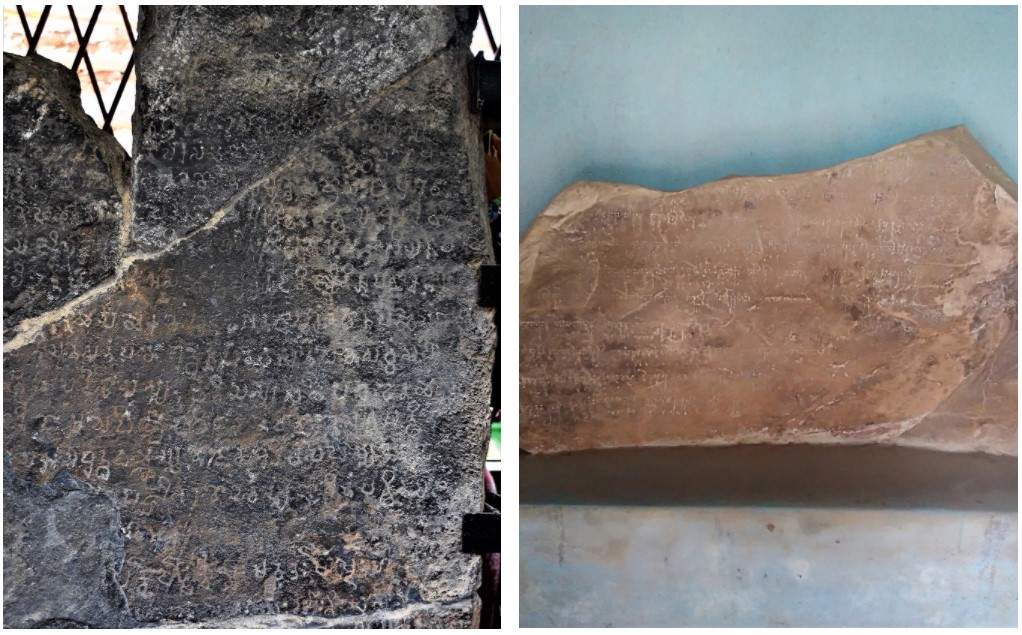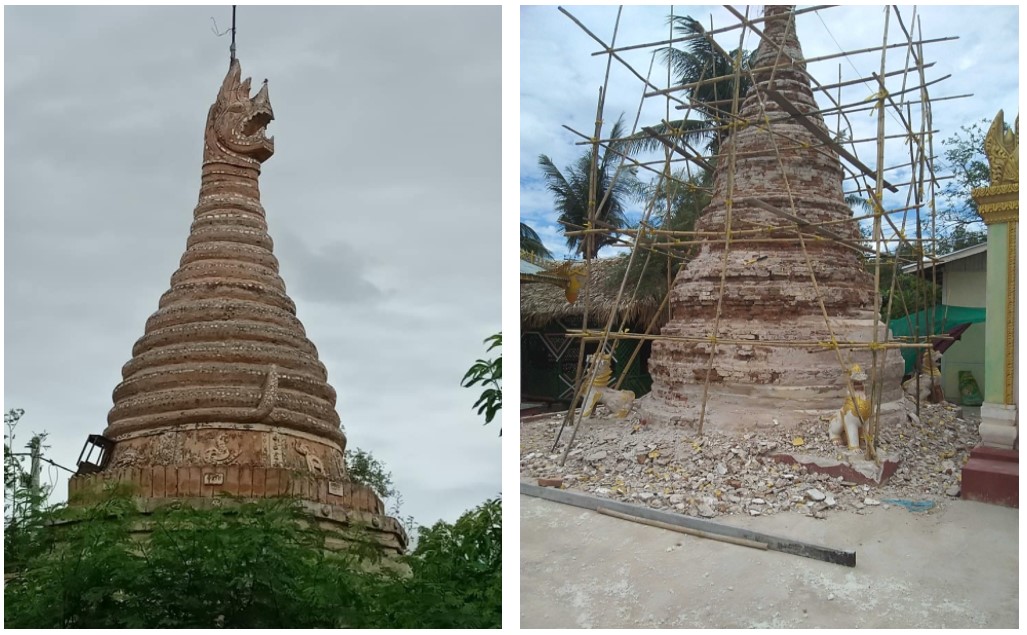December 12, 2020
Many stone plaques were reliable in searching firm evidence to discover the history of Myanmar. Historical images of respective eras were unveiled by reading the records on ancient stone plaques. Myanmar Encyclopaedia mentions stone plaques reflecting ideologies, fine cultural arts and social relations in their carving eras contributed much to the history of the country.
The stone inscription department was established in Myanmar in 1902. It was reconstituted as the Archaeology Department in 1954 to carry out stone inscription research such as collection of stone inscriptions, copying ink inscriptions, translation and publishing papers. The stone inscriptions are preserved at the originally excavated sites, museums and stone inscription chambers.
Archaeologist U Myint Aung wrote that there might be some 3,000 stone plaques found across Myanmar; stone inscriptions were mostly carved on marble slabs and shale slabs; and most of the stone plaques were found in central Myanmar. The UNESCO recognized 729 stone plaques bearing Tri Pitakat treatises posted by King Mindon in the precinct of Mandalay’s Kuthodaw Pagoda and Rajakumar stone plaque located on the platform of Mya Ceti in Bagan and Bagan Archaeological Museum as the Memory of the World.
All stone inscriptions found in Myanmar were carved in Sanskrit language with the use of Devanagari alphabets, Pali language with the use of any alphabets used in southern India, Pyu language with the use of separate alphabets, Mon language with Mon alphabets and Myanmar language with Myanmar alphabets, said Dr Maung Maung Swe, Professor of Myanmar Department from Sagaing University of Education.
Among the stone inscriptions, the stone plaque found in the precinct of Paytaw Parahita Monastery in Myittha Township of Mandalay Region was very popular among the researchers. To change the stone inscriptions to the alphabets and carry out translation, the Ministry of Culture held a forum in 2013.
Myittha in the history
Myittha was an ancient city, named Mlithakharon involved in Letwin 11 districts established by Bagan King Anawrahta. King Badon (1782-1819 AD) set up Letwin nine districts formed with Myaunghla, Myinkhontaing, Panan, Myinsoe and Makkhaya from Zawgyi District and Sawhla, Pinle, Myittha and Pyimana from Panlaung District. Myittha was moved from Panlaung four districts to Letwin nine districts.
Kyaukse plain was famous as Letwin 11 districts formed with Panan, Tamok, Myinkhontaing, Ywamon and Thintaung from Kyaukse Township, Pinle, Pyimana and Myittha from Myittha Township and Makkhaya, Tapyettha and Khanlu from Singaing Township.
According to the records of the Ministry of Home Affairs, the name of town Mlittha was titled by King Anawrahta who built Kinta, Ngalaithin, Pyaungpya, Kyime, Natet, Thintwe and Minye dams based on Panlaung and Zawgyi rivers so as to irrigate 800,000 pels of farmlands. Kyime Dam as last facility was built on Panlaung River.
In the time of the Revolutionary Council, the Ministry of Home and Religious Affairs set up Myittha on 31 August 1972 and wards and village-tracts on 16 June 1973. Myittha Township was formed with six wards and 233 villages in 82 village-tracts.
Myittha is 16 miles south to Kyaukse and 48 miles south to Mandalay. The town is 20 miles long from the east to the west and 17.5 miles wide from the south to the north. It is located on 342.63 square miles of land. Myittha Township is sharing border with Ywangan Township in the east, Natogyi Township in the west, Wundwin Township in the south-west, Kyaukse Township in the north and TadaU Township in the north-west.
A total of 565 pagodas and 268 monasteries scatter in the township. Everybody can pay homage to a pagoda rounded by dragon statue and observe King Sawlu’s stone inscription which is 33 years earlier than Rajakumar stone inscription in the precinct of Paytaw Parahita Monastery in Myittha. Likewise, Myanadi stone inscription carved in Pyu language can be seen in the precinct of Shwemuhtaw Pagoda in Myittha.
Paytawkon stone inscription
These are three broken pieces of stone plaque found in the precinct of the monastery on 4 November 2013. One more broken piece was found on 5 November. The stone plaque combined with the broken pieces is 5.75 feet long, 3.5 feet wide, seven inches thick on the bottom part and five inches thick on the top part. The stone plaque is black limestone. Both sides of the plaque were carved with inscriptions. Remaining broken pieces of the plaque were not found yet.
That stone inscription was read by Pyu literature scholar U Sein Win, Mon literature scholar Nai Ba Shin, historian Tampawady U Win Maung and researcher U Myint Hsan (Mickey Heart). They wrote articles based on it. The stone plaque was carved back to back with inscriptions. The side of Mon language comprised 29 lines and the side of Pyu language, 33 lines. Five top lines of Mon language could not be read. Sayagyi Nai Ba Shin mentioned the year in 18th line of Mon language as 441 but some assumed it as 415. (Horoscope History mentioned King Sawlu was born in 411. So the year 415 would be the four-year old for Sawlu. U Kalar Maha History mentioned King Sawlu came onto the throne in 397. So, it was different from the year of the stone inscription.)

The 7th line on Mon language side and 1st and 16th lines on Pyu language side expressed the title of King Sawlu as Barajabharana Deva. So, it proved that the stone inscription in Paytaw Monastery was carved under the order of King Sawlu.
Twelve upper lines of Pyu side was carved in Sanskrit language with Devanagari alphabets, 12 middle lines in Pali language with Kadamba alphabets and lower seven lines in Pyu language with Pyu alphabets. On other side, all the lines were carved in Mon language with Mon alphabets. So the stone inscription was carved in four languages with four alphabets, said Pyu literature scholar U Sein Win.
Nai Ba Shin translated Mon alphabets in stone inscription into Myanmar language and U Myint Hsan, Pyu language to Myanmar.
Sayagyi Tampawady U Win Maung said writing style in Barajabharana Deva (sa) on Pyu side was similar to that from golden palm leave in Khinba mound of Sri Kestra and Thaye Thamein stone inscription carved between 5th and 7th centuries where such drawing rule of alphabets was practised in southern India.
Some scholars assumed five languages were used in Paytaw Monastery’s stone inscription but some, five languages. The stone inscription department in India mentioned such alphabets were early Nagari alphabets.
Thanks to changing of alphabets by scholars, everybody knows main theme of the stone inscription, mentioning that King Sawlu enshrined two of three Buddha images and donated the remaining one to the pagoda with a ceremony of sharing merits for donation of 100 slaves, 10 pairs of oxen, 100 pels of farmlands and 1,000 baskets of paddy.
The Paytaw Monastery’s stone inscription was carved in 441 ME, 33 years earlier than Rajakumar stone inscription carved in 474 ME recognized as the Memory of the World. As the stone inscription bearing Pyu and Mon languages was found in Myittha area, it is expected to fill the blanks of the history.
Four broken parts of the stone inscription was combined and is being maintained at the stone inscription chamber in the precinct of Paytaw Parahita Monastery. Such chamber was inaugurated on 24 June 2014.
Pyu stone inscription in Myittha area
A stone plaque bearing Pyu language was found in Myittha and is being kept in the chamber in the precinct of Shwemuhtaw Pagoda in Myittha. The stone plaque bearing 10 lines of Pyu language is five feet and 11 inches long and two feet and eight inches high. Its thickness is between three inches and five inches. Since finding, the top of the plaque had broken.
Myanadi Village is located close to Panlaung River, 10 miles northeast of ancient Pinle city which is five miles southeast of Kume in Myittha Township. The stone plaque found beside the route of bullock cart, a half mile southeast of the village was named Myanadi stone inscription based on the title of the village.
Myanadi stone inscription bearing Pyu language was found earliest in Letwin 11 districts but any other ancient objects were not found there. U Kyaw Sein and U Hla Maung from Myanadi Village excavated the plaque.
Archaeologists from a field team of Department of Archaeology and National Museum reviewed that as any clue could not be found near the site where Myanadi stone plaque was excavated, anyone could not guess how the plaque arrived there. Possibly, the stone plaque was taken from another site or the stone inscription was carved on the stone produced from Myanadi area. So, the team remarked the stone inscription might be carved between 7th and 8th centuries.
The stone plaque of Myanadi was harder than the shale one. So, alphabets were not carved on the rough spaces. The stone might be produced from the area, and rocks from the route to the southeast of Myanadi Village were similar to the plaque of stone inscription, according to archaeologist U Kyaw Myo Win.
As a Pyu stone plaque and another stone plaque in Bagan era were found in Myittha Township where Pyu culture flourished in the past, Myittha area is attractive to scholars and researchers.
(Translated by Than Tun Aung)
References:
Ancient Mongmaw City (Archaeology Department)
Selected Pyu alphabets literature Volume I (U Sein Win)
Stone inscription of Paytaw Monastery (Ni Tut, Professor of History Department)
Papers on stone inscriptions from Paytaw Monastery


